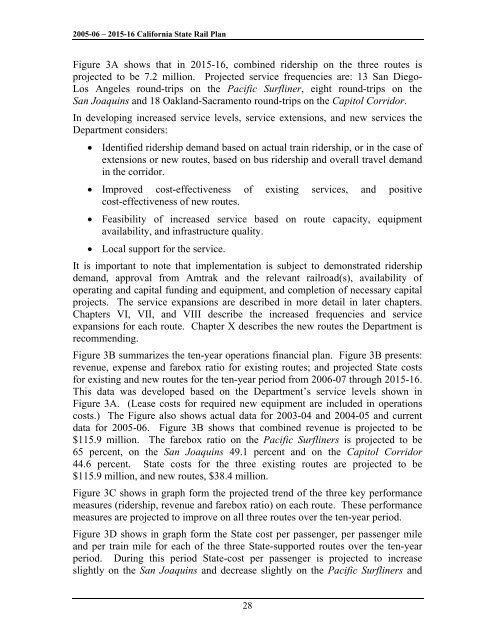California State Rail Plan 2005-06 to 2015-16
California State Rail Plan 2005-06 to 2015-16
California State Rail Plan 2005-06 to 2015-16
Create successful ePaper yourself
Turn your PDF publications into a flip-book with our unique Google optimized e-Paper software.
<strong>2005</strong>-<strong>06</strong> – <strong>2015</strong>-<strong>16</strong> <strong>California</strong> <strong>State</strong> <strong>Rail</strong> <strong>Plan</strong><br />
Figure 3A shows that in <strong>2015</strong>-<strong>16</strong>, combined ridership on the three routes is<br />
projected <strong>to</strong> be 7.2 million. Projected service frequencies are: 13 San Diego-<br />
Los Angeles round-trips on the Pacific Surfliner, eight round-trips on the<br />
San Joaquins and 18 Oakland-Sacramen<strong>to</strong> round-trips on the Capi<strong>to</strong>l Corridor.<br />
In developing increased service levels, service extensions, and new services the<br />
Department considers:<br />
• Identified ridership demand based on actual train ridership, or in the case of<br />
extensions or new routes, based on bus ridership and overall travel demand<br />
in the corridor.<br />
• Improved cost-effectiveness of existing services, and positive<br />
cost-effectiveness of new routes.<br />
• Feasibility of increased service based on route capacity, equipment<br />
availability, and infrastructure quality.<br />
• Local support for the service.<br />
It is important <strong>to</strong> note that implementation is subject <strong>to</strong> demonstrated ridership<br />
demand, approval from Amtrak and the relevant railroad(s), availability of<br />
operating and capital funding and equipment, and completion of necessary capital<br />
projects. The service expansions are described in more detail in later chapters.<br />
Chapters VI, VII, and VIII describe the increased frequencies and service<br />
expansions for each route. Chapter X describes the new routes the Department is<br />
recommending.<br />
Figure 3B summarizes the ten-year operations financial plan. Figure 3B presents:<br />
revenue, expense and farebox ratio for existing routes; and projected <strong>State</strong> costs<br />
for existing and new routes for the ten-year period from 20<strong>06</strong>-07 through <strong>2015</strong>-<strong>16</strong>.<br />
This data was developed based on the Department’s service levels shown in<br />
Figure 3A. (Lease costs for required new equipment are included in operations<br />
costs.) The Figure also shows actual data for 2003-04 and 2004-05 and current<br />
data for <strong>2005</strong>-<strong>06</strong>. Figure 3B shows that combined revenue is projected <strong>to</strong> be<br />
$115.9 million. The farebox ratio on the Pacific Surfliners is projected <strong>to</strong> be<br />
65 percent, on the San Joaquins 49.1 percent and on the Capi<strong>to</strong>l Corridor<br />
44.6 percent. <strong>State</strong> costs for the three existing routes are projected <strong>to</strong> be<br />
$115.9 million, and new routes, $38.4 million.<br />
Figure 3C shows in graph form the projected trend of the three key performance<br />
measures (ridership, revenue and farebox ratio) on each route. These performance<br />
measures are projected <strong>to</strong> improve on all three routes over the ten-year period.<br />
Figure 3D shows in graph form the <strong>State</strong> cost per passenger, per passenger mile<br />
and per train mile for each of the three <strong>State</strong>-supported routes over the ten-year<br />
period. During this period <strong>State</strong>-cost per passenger is projected <strong>to</strong> increase<br />
slightly on the San Joaquins and decrease slightly on the Pacific Surfliners and<br />
28













